
The Windsor Avenue Congregational Church is a historic church at 2030 Main Street in Hartford, Connecticut. The brick Romanesque Revival-style church building, completed in 1872, now houses Faith Congregational Church, whose lineage includes the city's oldest African-American congregation, established in 1819. The church is a stop on the Connecticut Freedom Trail and was listed on the United States National Register of Historic Places in 1993.
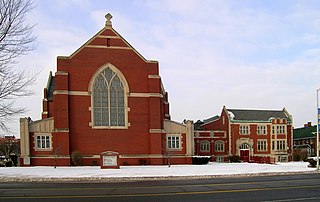
The St. John's Christian Methodist Episcopal Church is a church located in Detroit, Michigan. It was built as the North Woodward Congregational Church, listed on the National Register of Historic Places in 1982, and designated a Michigan State Historic Site in 1998.

North Avenue Congregational Church is a historic church meetinghouse at 1801 Massachusetts Avenue in Cambridge, Massachusetts. It was completely renovated in 2015 to become a library for Lesley University. The former church now forms part of what is now the Lunder Arts Center complex.

The Society of the Congregational Church of Great Barrington is an historic church building and parish house located at 241 and 251 Main Street in Great Barrington, Massachusetts. It is the fourth church of a congregation whose first meetings were held in 1743.

The former First Unitarian Church is a historic church building at 130 Highland Avenue in Somerville, Massachusetts. The stone church was built in 1894 for a Unitarian congregation. It was designed by Hartwell & Richardson and is a good example of Richardsonian Romanesque design. The building presently (2022) houses the Mission Church of Our Lord Jesus Christ.

The Mount Carmel Congregational Church and Parish House is a historic church complex at 3280 and 3284 Whitney Avenue and 195 Sherman Avenue in Hamden, Connecticut. It consists of an 1840 Greek Revival church with a tetrastyle temple front portico, and a 1911 Colonial Revival parish house. A non-contributing 1925 sexton's house is also on the property. The church is considered to be Hamden's finest example of Greek Revival architecture, and the parish house one of its finest Colonial Revival houses. The property was listed on the National Register of Historic Places in 1991.

The Marlborough Congregational Church is a historic Congregational Church at 35 South Main Street in Marlborough, Connecticut. Built in 1842, it is a well-preserved example Greek Revival architecture. In addition hosting religious services, it also hosted town meetings for many years. It was listed on the National Register of Historic Places in 1993.

The Rocky Hill Congregational Church is a historic church at 805-817 Old Main Street in Rocky Hill, Connecticut, USA. Built in 1808 for a 1723 congregation, it is a distinctive late example of Georgian architecture, and a prominent landmark in the town center. The building was listed on the National Register of Historic Places in 1982.

Shoreham Congregational Church is a historic church on School Street in Shoreham, Vermont. Built in 1846 by a local master builder, it is one of the state's finest examples of ecclesiastical Greek Revival architecture, and also housed local town meetings for more than a century. It was listed on the National Register of Historic Places in 2001.

The First Church of Christ and the Ancient Burying Ground is a historic church and cemetery at 60 Gold Street in Hartford, Connecticut, United States. It is the oldest church congregation in Hartford, founded in 1636 by Thomas Hooker. The present building, the congregation's fourth, was built in 1807, and was listed on the National Register of Historic Places in 1972. The adjacent cemetery, formally set apart in 1640, was the city's sole cemetery until 1803.

The Metropolitan African Methodist Episcopal Zion Church is a historic Methodist Episcopal Church at 2051 Main Street in Hartford, Connecticut. This High Victorian Gothic structure was built in 1873-74 for an Episcopal congregation, and has since 1926 been the home to the city's oldest African-American congregation, which was established in 1833. The church was listed on the National Register of Historic Places in 1994.

The Second Church of Christ, known more recently as the South Congregational Church, is a historic church in Hartford, Connecticut. Built in 1825–27, it is one of the oldest surviving public buildings in the city. It is the third home of its congregation, which was founded in 1670, and is one of the oldest purely Congregationalist groups in the nation. The building was listed on the National Register of Historic Places in 1978.

The Union Baptist Church is a historic church at 1913 and 1921 Main Street in Hartford, Connecticut. Originally built by an Episcopal congregation, it has for many years been home to an African-American Baptist congregation, which under the leadership of Rev. John C. Jackson (1866-1953), played a significant role in advancing the cause of civil rights in the state. The church, and its adjacent parsonage, were listed on the National Register of Historic Places in 1979.
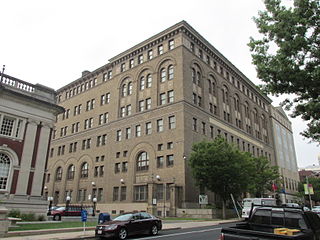
The Elm Street Historic District encompasses a collection of architecturally distinguished institutional and residential buildings near the Connecticut State Capitol in Hartford, Connecticut. Located on Capitol Avenue and Trinity and Elm Streets, it includes the city's best concentration of early 20th-century architecture, including Bushnell Memorial Hall and several state office buildings. It was listed on the National Register of Historic Places in 1984.
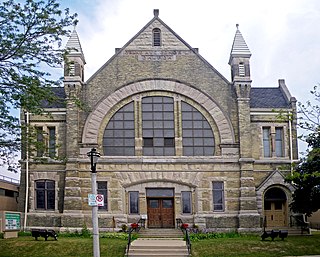
The Grand Avenue Congregational Church is a historic Romanesque Revival church built in 1888 in Milwaukee, Wisconsin. It was added to the National Register of Historic Places in 1986.

Beth Hamedrash Hagodol Synagogue is an historic former Orthodox Jewish congregation and synagogue, located at 370 Garden Street, Hartford, Connecticut, in the United States.
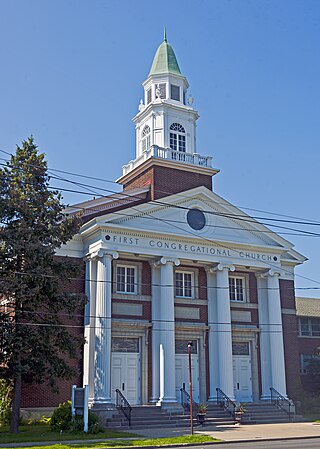
The First Congregational Church of Albany, also known as The Ray Palmer Memorial, is located on Quail Street in the Woodlawn section of Albany, New York, United States. It is a brick building in the Colonial Revival architectural style built in the 1910s and expanded half a century later. In 2014 it was listed on the National Register of Historic Places.
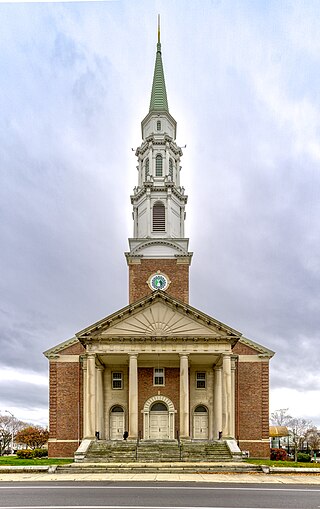
The Bridgeport Islamic Community Center is a religious center serving the Muslim population in the greater Bridgeport, Connecticut area. Founded in 2002, it is located at 377 Park Avenue in the city's west end, in a former Congregational Church built in 1926. The building is listed on the National Register of Historic Places for its architecture and association with its former congregation, whose history dates to the 17th century. The center provides educational, support, and outreach services to the community.

The Vine Street Apartment Buildings, many now known as the Horace Bushnell Apartments, are a historic collection of residential apartment blocks at 4-48 Vine Street in Hartford, Connecticut. Built between 1922 and 1925, they consist of eleven brick buildings sharing massing, scale, and setting, with a cross-section of period building styles. They were listed on the National Register of Historic Places in 2012.

Davis & Brooks was an American architectural firm based in Hartford, Connecticut, active from 1897 to 1919. It was established by F. Irvin Davis (1869-1944) and William F. Brooks (1872-1950). Among their projects is the Hartford Municipal Building, completed in 1915.






















